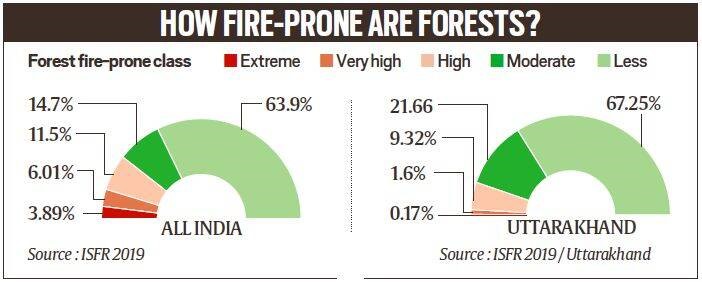
05/04/21 17:00 PM IST


What causes forest fires?
Why is the current situation worrisome?

When Uttarakhand witnessed these types of fires previously?
Uttarakhand had witnessed its worst wildfire in 2016 when over 4433 hectares was gutted in 2074 incidents of forest fires. Six people had died while four had sustained severe injuries. At the time, forest fires had remained unnoticed for several days following a political crisis in the state that had led to the imposition of the President’s rule. According to an official, forest fires were reported from 1200 places on a single day, April 26, that year. In the emergency situation that had ensued, the option of cloud seeding was unsuccessfully explored/ Then, helicopters were used for the first in the state to douse fire. While the temperature was very high at that time, the fuel load was very less and wind velocity was weak. Considering these last two factors, experts say 2021 may witness wildfire worse than 2016 and natural rain is the last hope.
Where mostly these fires are seen?
Who published the “Strengthening Forest Fire Management in India” report?
A joint study report of the Ministry of Environment and Forests (MoEF&CC) and World Bank titled “Strengthening Forest Fire Management in India” released in June 2018 revealed that in the year 2000, 20 districts, representing 3% of India’s land area and 16% of forest cover accounted for 44% of all fire detections. The report discusses policies on forest fire prevention and management (FFPM) at the national, state and local levels, underscoring the need for a comprehensive national policy and guidelines. It provides recommendations on five broad themes – policy, institutions and capacity, community engagement, technology, and data and information and looks at national and international best practices in FFPM.
How these fires can be stopped?
The Forest Fire Prevention and Management Scheme (FPM) is the only centrally funded program specifically dedicated to assist the states in dealing with forest fires.

17 Sep
'Dehradun and several other districts in Uttarakhand have experienced very heavy rainfall over the past few days, triggering landslides in multiple areas and causing rivers to swel
Read More
08 Sep
'The Rajasthan Coaching Centres (Control and Regulation) Bill, 2025, is a significant piece of legislation passed by the Rajasthan Assembly to regulate and oversee the state's burg
Read More
28 Aug
'Recently, the Indian Space Research Organisation (ISRO) successfully carried out its first Integrated Air Drop Test (IADT-1), a crucial milestone in the preparation for the countr
Read More